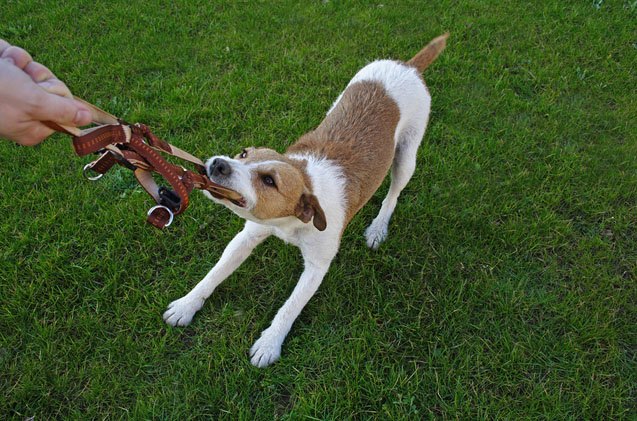6 Common Mistakes You’re Making When Training Your Dog

One of your most important tasks as a dog owner is to properly train your dog. Despite what many people think, basic dog training is not just about learning where to go potty or responding to commands. Training a dog involves more than just teaching him to sit and stay – you also need to housetrain your dog, socialize him, and make sure that he learns basic obedience. The goal of training is to mold your puppy into a well-behaved, well-balanced, and content pet that will know what is expected of them. As pack animals, dogs benefit from having an authority figure and respond well to structure and rules, so when you know how to properly train your canine friend, the results will be fantastic, even if you’re not a pro. Unfortunately, there is a great deal of misinformation out there about dog training which results in a number of common mistakes that dog owners make while training.
It’s easy to fall trap to these misconceptions, especially if you don’t have much experience training dogs in the first place. After all, how is anybody supposed to pick out frauds from experts on the Internet? But don’t worry- we’ve got you covered even if this is your first time owning and training a dog. Here is a list of the top six training errors that dog owners make so you can learn to avoid those mistakes or correct how you’ve been training.
Many dog owners make the mistake of using punishment as a training method. And we’re not talking about aggressive or abusive training methods such as yelling or beating. There are other aversive methods that have an equally detrimental effect but are, for some reason, widely accepted as proper training methods. One of the most common examples is rubbing a dog’s nose in his mess if he has an accident in the house. It’s likely that if you haven’t ever done this that you’ve heard of someone saying it’s a foolproof method of potty training puppies. Wrong!
These dog owners mistakenly believe that rubbing the dog’s nose in it will teach him what he is being punished for but, in reality, it just confuses (and might even scare) your dog. Punishment-focused training works by teaching your dog to fear the potential consequences of acting in a way that you don’t deem to be appropriate. However, if you haven’t taken the time to teach your dog what you expect, how can you expect them to follow your rules? In addition to confusion, this can even lead to anxiety where your dog starts to worry about doing anything in their home out of fear of punishment. This can lead to additional behavioural issues, making the whole situation worse.
Using aversive methods such as this one can also ruin your relationship with your pet, as they can end up fearing you instead of feeling like you’re their pack leader.
Positive-reinforcement training – methods that involve rewarding your dog for good behavior rather than punishing bad behavior – are infinitely more effective. They teach your dog to act appropriately because they WANT to act appropriately to enjoy the prize that they know is waiting if they do. It may seem like a small shift in thinking, but it can have a major impact on the effectiveness of your training efforts. This training method will help you build a bond with your dog rather than tearing it down.
Related: Head’s Up, Dog Trainers: Why You Should Treat Humans Likes Dogs
The key to training your dog is to do it often. Spending one or two hours a week training your dog won’t get you anywhere, unfortunately. Even though many dogs are smart enough that they learn quickly, it still takes a lot of repetition for a behavior to become ingrained and for a dog to respond consistently to a given command. You should engage in several short training sessions per day when you are initially training your dog and then reduce it to one or two reinforcement sessions each week.
In more ways than one, dogs are like little kids. In this instance, it’s their attention span: it can be super short, but you still shouldn’t let them dictate the pace of the training. If you try to make your training sessions too long your dog could become bored or frustrated – when that happens he might stop listening to you and you will both become frustrated. When we become frustrated with a project that we are walking on, we are often told to step away, take a breath and return to it with a clear mind and fresh eyes. Why not apply this same concept to our dogs? There may be times that you have to end your training session a little early when you see that your dog has hit a wall, and that’s okay! It’s better to end a couple of minutes early than to turn training into a negative experience by continuing to push your dog (and yourself) through frustration.
On the opposite end of the spectrum, keeping your training sessions too short could prevent your dog from properly identifying the desired behavior. We’re not saying your pooch is a dum dum, don’t worry, it’s just that most dogs need a bit of time before figuring out what exactly you want them to do. Aim for several 10 to 15-minute training sessions a day and cut them off when your dog starts to get bored. No pooch is hyper that much that 15 minutes of training is boring- keep it short and sweet and you’ll see results.
Related: The Basics About Dog Body Language
Yes, we all know that the saying “the way to a man’s heart is through his stomach” applies to man’s best friend, too. Food is an excellent motivator for dogs but you shouldn’t go overboard. Use treats for the first few repetitions of your training sessions – only until your dog positively identifies the desired behavior. After that, you should cut back to rewarding your dog only every few repetitions but keep praising him every time he responds correctly. Dogs love getting positive attention almost as much as they like treats but your love won’t get them obese, so feel free to praise away. Also, a bonus tip: studies have shown that that high-pitched baby voice we use when we talk to our dogs (don’t deny it) improves the bond- feel free to baby talk when you tell your pooch that he’s done a good job.
Another great option for rewarding your dog is their favourite toy or activity. For example, if you have a dog that LOVES playing tug, keep a tug toy in your hand. When they perform a command properly, a short game of tug can be just as rewarding and positive as any food-based treat. The same idea can be applied to a dog that prefers a game of fetch. If you keep a tennis ball in hand during training, you are prepared for a quick game of fetch, throwing the ball a couple of times, to praise your dog for listening.
We can’t stress it enough: consistency is the key. You can teach your dog to do just about anything if you are consistent in your training methods. First, you need to be consistent in using the same verbal command every time. If you start to use different phrases or commands interchangeably, this can cause confusion. Your dog won’t understand what you are asking them to do and if they don’t understand, they aren’t going to respond in the way that you want them to. Stick with easy, short commands, ideally one or two words at most. For those that prefer to also incorporate hand gestures with their commands, these must also remain consistent.
The command isn’t the only part of training that this rule applies to. You must also be consistent in praising and rewarding your dog every time he responds correctly. Once a command or behavior has become ingrained you can cut back on food rewards but always praise your dog for responding correctly. Even when it’s a thousandth time that your pooch is sitting down like a good boy he is, don’t forget to applaud their effort. A quick ‘good boy’ or ‘good girl’ with a pet can go a long way and it doesn’t cost you anything more than a few seconds of your time. They’ve earned it!
During training, you need to establish yourself as an authority figure so your dog will respect you and listen to your commands. You might want to pet and snuggle your pooch all the time, but the training time should be “business” time. This will help your dog understand that they need to focus and listen when you are giving a command as they will associate your tone of voice and body language with serious time. Pay attention to how you say your commands and carry this over to the real-world application of your training. Always give your commands with a firm and authoritative voice (but not an angry voice) to see the best results.
Do not take this too far, however, and force your dog to become submissive – this will only encourage him to fear you. Try to find a balance between being an authority figure for your dog while also developing a loving a trusting bond with him.
The beauty of dog training is that you can train your dog to do just about anything if you employ the proper method and use the right motivation. If you find that you are making one or more of the training mistakes discussed above it is not the end of the world – all you have to do is correct the mistake and your dog will adjust.

Kate Barrington is the loving owner of two cats (Bagel and Munchkin) and a noisy herd of guinea pigs. Having grown up with golden retrievers, Kate has a great deal of experience with dogs but labels herself a lover of all pets. Having received a Bachelor's degree in English, Kate has combined her love for pets and her passion for writing to create her own freelance writing business, specializing in the pet niche.
More by Kate Barrington























